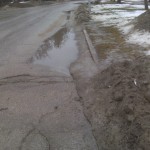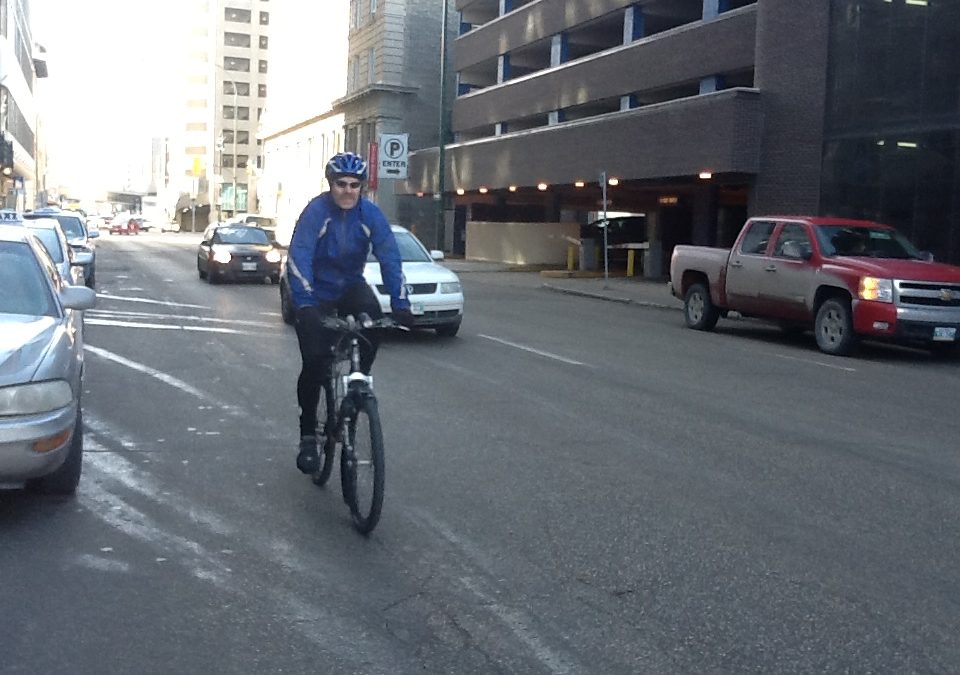While many cyclists will wait for the snow to melt and the streets to dry up, there are the early adopters that will want to take advantage of the warmer temperatures that we have been experiencing and get out there for some early spring riding. We asked our resident bike nut Dave for some advice on how to navigate the puddle and often pothole-filled streets.
Here are some of his tips:
- Ride at least a metre out from the edge of the “rideable” surface. This means that if there is half a metre of solid ice sloping down off the curb, you need to stay a metre away from that edge. Yes, that puts you 1.5 metres away from the curb, but gives you room to manoeuvre if you encounter a pothole or some ice.

Photo: Green Action Centre
- Don’t ride through puddles. They also do not represent a rideable surface and can contain hidden treasures like potholes or underlying ice that you really do not want to find with your bike wheel. If the puddle is large and takes up the entire right lane, wait for a break in traffic, signal and use the other lane to go around it.
- When temperatures drop slightly below zero, those wet streets can transform into skating rinks, especially in areas not well traveled by cars. This is when studded tires really can make a difference. It is sometimes a better decision to take the road “more” traveled when streets have the potential to be slippery.
- Sand spread during the winter might work for cars, but not necessarily for bikes. Sand can accumulate in thick layers along the edge of roadways or can also result in thin layers of wet, fine sand that can be very slippery. Be cautious on sand especially when turning.
- We have all heard about Winnipeg potholes, however over the winter many new ones will be created and old ones that were patched will reappear. Be alert and watch for potholes so you don’t end up being swallowed by one.
- You can’t avoid the spray from car tires, but you can prepare for it. Most of the time you will not need waterproof splash pants (not that they are a bad idea), but a jacket that at least resists water is a good idea. You might want to also consider some kind of eyewear to avoid getting this messy spray in your eyes.
Here are a couple of other tips for your bike:
- Full fenders are a good idea and will keep you cleaner and drier. They will also come in handy all summer long during rainy weather.
- It is impossible to keep your bike clean, but it is a good idea to at least spray some of the grit off of it when you can. These particles can work their way into the moving parts of your bike and wear away surfaces that are expensive to repair or replace. In particular, try to keep your brakes and wheel rims clean. Fine grit on your rims will wear away surface and more importantly reduce your braking efficiency.
- Keep your chain well lubricated. The wet conditions combined with the salt on the streets can quickly rust a chain. Pay particular attention to lubricating the bushings or pivot points of the chain. If these areas rust, the chain will not run smoothly through the drivetrain of your bike and will need to be replaced. Use a lubricant designed for a bike, not motor oil or worse yet WD-40. (It’s a solvent, not a lubricant)
Dave has been a bike commuter for over 25 years, is a certified CAN-BIKE Cycling Safety and Skills instructor and is the Director of Safety and Education for Bike to the Future.




Thanks for the tips Dave. I just cleaned my bike yesterday (I used steel wool on some parts to get at some of the rust) and re-lubricated the chain.